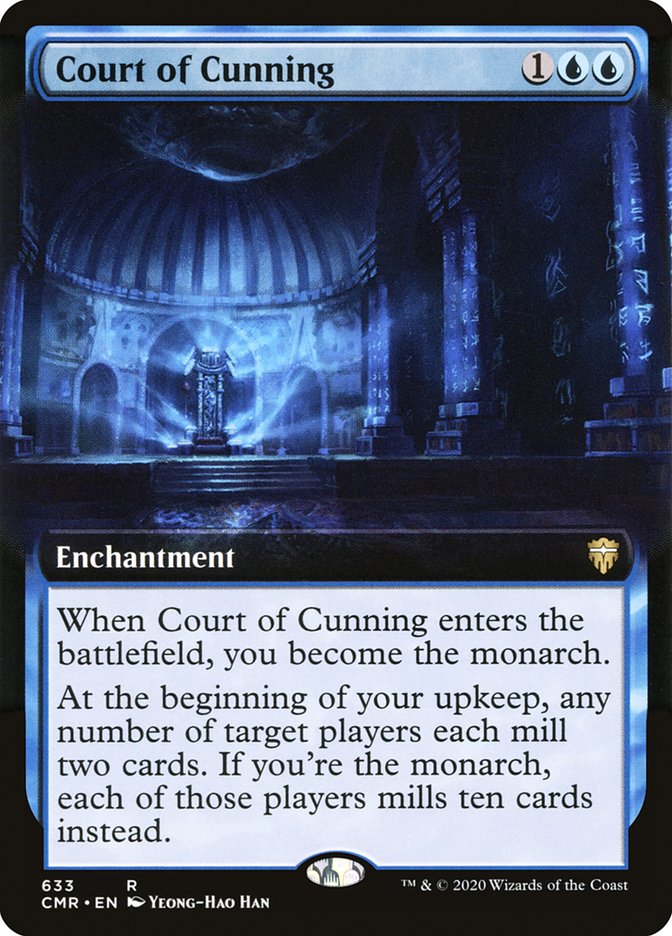Court of Cunning Carta MTG
| Expansões | Lançada em 3 expansõesVer todas |
| Custo de mana | |
| Custo convertido de mana | 3 |
| Raridade | Rara |
| Tipo | Enchantment |
| Habilidades | Mill |
Decks que usam a carta
Decks de MTG usando Court of Cunning. Aprofunde-se na estratégia dos decks, cartas de sideboard, listar ideias e exportar para jogar na ARENA ou MOL.
| # | Nome | Formato | Arquétipo | Evento |
|---|---|---|---|---|
 | UB | Legado | Legacy Challenge 32 2024-04-14 | |
 | Dimir Scam | Legado | Dimir Scam | 2023 NA Legacy Champs |
Onde comprar
Se você deseja comprar um cartão Court of Cunning MTG de um conjunto específico como Magic Online Promos and Commander Legends, há diversas opções confiáveis a serem consideradas. Uma das principais fontes é a loja de jogos local, onde muitas vezes você pode encontrar boosters, cartas individuais e decks pré-construídos de conjuntos atuais e de alguns conjuntos anteriores. Eles geralmente oferecem o benefício adicional de uma comunidade onde você pode negociar com outros jogadores.
Para um inventário mais amplo, especialmente de conjuntos mais antigos, mercados on-line como TCGPlayer, Card Kingdom e Card Market oferecem seleções extensas e permitem que você pesquise cartas de conjuntos específicos. Grandes plataformas de comércio eletrônico, como eBay e Amazon, também têm listagens de vários vendedores, o que pode ser um bom lugar para procurar produtos lacrados e achados raros.
Além disso, o site oficial do Magic geralmente tem um localizador de lojas e listas de varejistas para encontrar a Wizards of the Produtos licenciados pela Costa. Lembre-se de verificar a autenticidade e a condição dos cartões ao comprar, especialmente de vendedores individuais em mercados maiores.
Abaixo está uma lista de alguns sites de lojas onde você pode comprar os Court of Cunning e outras cartas MTG:
 COMPRAR
COMPRAR BurnMana é parceiro oficial da TCGPlayer
- eBay
- Card Kingdom
- Card Market
- Star City Games
- CoolStuffInc
- MTG Mint Card
- Hareruya
- Troll and Toad
- ABU Games
- Card Hoarder Magic Online
- MTGO Traders Magic Online
Veja produtos de MTG
Expansões
A carta Court of Cunning Magic the Gathering foi lançada em 2 expansões diferentes entre 2020-11-20 e 2020-11-20. Ilustrado por Yeong-Hao Han.
| # | Lançamento | Nome | Código | Símbolo | Número | Moldura | Layout | Borda | Artista |
|---|---|---|---|---|---|---|---|---|---|
| 1 | Magic Online Promos | PRM | 85980 | 2015 | Normal | Preta | Yeong-Hao Han | ||
| 2 | 2020-11-20 | Commander Legends | CMR | 633 | 2015 | Normal | Preta | Yeong-Hao Han | |
| 3 | 2020-11-20 | Commander Legends | CMR | 63 | 2015 | Normal | Preta | Yeong-Hao Han |
Legalidades
Magic the Gathering formats where Court of Cunning has restrictions
| Formato | Legalidade |
|---|---|
| Commander | Válida |
| Legacy | Válida |
| Oathbreaker | Válida |
| Vintage | Válida |
| Duel | Válida |
Regras e informações
O guia de referência para regras de cartas de Magic: The Gathering Court of Cunning fornece decisões oficiais, quaisquer erratas emitidas, bem como um registro de todas as modificações funcionais que ocorreram.
| Data | Texto |
|---|---|
| 2020-11-10 | If combat damage dealt to the monarch causes that player to lose the game, the triggered ability that causes the controller of the attacking creature to become the monarch doesn't resolve. In most cases, the controller of the attacking creature will still become the monarch as it is likely their turn. |
| 2020-11-10 | If the monarch leaves the game during another player's turn, that player becomes the monarch. If the monarch leaves the game during their turn, the next player in turn order becomes the monarch. |
| 2020-11-10 | If the triggered ability that causes the monarch to draw a card goes on the stack and a different player becomes the monarch before that ability resolves, the first player will still draw the card. |
| 2020-11-10 | The game starts with no monarch. Once an effect makes one player the monarch, the game will have exactly one monarch from that point forward. As a player becomes the monarch, the current monarch (if any) ceases being the monarch. |
| 2020-11-10 | There are two inherent triggered abilities associated with being the monarch. These triggered abilities have no source and are controlled by the player who was the monarch at the time the abilities triggered. The full texts of these abilities are "At the beginning of the monarch's end step, that player draws a card" and "Whenever a creature deals combat damage to the monarch, its controller becomes the monarch." |


